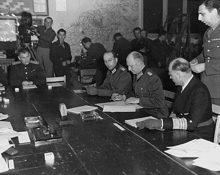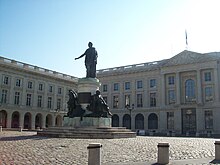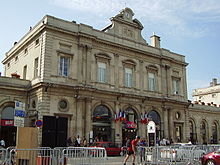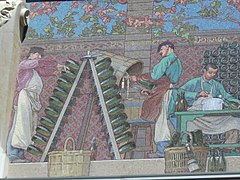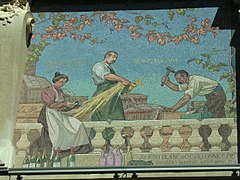Reims
| Reims | ||
|---|---|---|

|
|
|
| Motto: Dieu en soit garde - God forbid | ||
| region | Grand Est | |
| Department | Marne | |
| Arrondissement | Reims ( sub-prefecture ) | |
| Canton | Chief lieu of 9 cantons | |
| Community association | Grand Reims | |
| Coordinates | 49 ° 16 ' N , 4 ° 2' E | |
| height | 74-137 m | |
| surface | 46.90 km 2 | |
| Residents | 182,460 (January 1, 2017) | |
| Population density | 3,890 inhabitants / km 2 | |
| Post Code | 51100 | |
| INSEE code | 51454 | |
| Website | www.reims.fr | |
Reims ( [ ʀɛ̃s ] , German also [ʁaɪ̯ms]), formerly also written Rheims , is a city in Champagne in northeast France , about 130 kilometers from Paris .
Reims is the headquarters of the sub-prefecture of the arrondissement Reims in the department of Marne in the Région Grand Est . The city is the seat of an archbishop and has had a university (again) since 1971 . Champagne , but also textiles, food and equipment for space travel are produced in Reims . The history of the city goes back to the time before the Roman rule .
In Gemeindeverband Reims Métropole of the city with a total of 175 municipalities around the 290,000 people currently live about 220,000 people in the metropolitan area.
Geographical location and climate
| Reims | ||||||||||||||||||||||||||||||||||||||||||||||||
|---|---|---|---|---|---|---|---|---|---|---|---|---|---|---|---|---|---|---|---|---|---|---|---|---|---|---|---|---|---|---|---|---|---|---|---|---|---|---|---|---|---|---|---|---|---|---|---|---|
| Climate diagram | ||||||||||||||||||||||||||||||||||||||||||||||||
| ||||||||||||||||||||||||||||||||||||||||||||||||
|
Average monthly temperatures and rainfall for Reims
Source: wetterkontor.de
|
|||||||||||||||||||||||||||||||||||||||||||||||||||||||||||||||||||||||||||||||||||||||||||||||||||||||||||||||||||||||||||||||||||||||
Reims is located in the center of the Champagne , which occupies the wide, flat tiered eastern part of the Parisian basin . The city is located on a plain on the right bank of the Vesle , a tributary of the Aisne , and on the Canal de l'Aisne à la Marne . The Montagne de Reims rises to the south and west . Champagne is made from the grapes from the local vineyards . Part of the Montagne de Reims is part of the Montagne de Reims Regional Nature Park .
history
Roman times
The Reims area has been inhabited since the earliest times; so there are Bronze Age urn fields in the area . “According to legend, Reims was founded by Remus , the brother of Romulus , founder of ancient Rome. The inhabitants of the region therefore took the name Rèmes . ”In fact, however, the Celts founded around 80 BC. An urban settlement ( oppidum ), which they called Durocorter - "round castle". The Romans initially latinized this name to Durocortorum . After it was conquered by the Romans in the Gallic War , the city was renamed Civitas Remorum and was the capital of the Roman province of Belgica , named after the Remern , the Belger sub-tribe who lived here and were loyal to Rome . The privileges that the city received for its loyalty contributed to its prosperity.
The area was Christianized in late Roman times and the city was declared a bishopric . In 336 the Roman governor Jovinus defeated the so-called barbarians after they invaded Champagne. In 356 the battle of Reims took place against an Alemannic army.
middle Ages
The city was at the center of European history for centuries. Around 401 a church was built by Bishop Nicasus; the future saint was killed in the Vandals storming the city in 406. In 451 the Huns under Attila conquered the city, but withdrew after the battle on the Catalaunian fields (not far from Reims). In the city's cathedral, between 497 and 499, Clovis I was baptized by Bishop Remigius , which was decisive for the development of the Frankish Empire . The importance of the city, which soon also became the seat of an archbishop, is also shown in the fact that it was the residence of a part of the empire during the Merovingian divisions.
In the 8th century, the Frankish King Pippin the Younger met with Pope Stephan III in Reims . and later Pope Leo III. with Charlemagne . The first coronation took place in Reims in 816, when the Franconian Ludwig the Pious , appointed co-emperor by his father Charlemagne during his lifetime, was once again crowned emperor there by Pope Stephan IV after Charles's death . The kings Karlmann I († 771), Ludwig IV. († 954) and Lothar († 986) were buried in the Basilica of Saint-Remi .
In the 10th century, the Archbishop Adalberon was instrumental in ensuring that the French reign passed from the House of Carolingians to the Capetians . Together with Gerbert von Aurillac , he also ensured that the city with its cathedral school became an intellectual center of the early Middle Ages . Reims remained the city where the French kings were anointed and crowned from the 12th to the 19th centuries; a conscious connection to the tradition started by Clovis. For example, it had a high symbolic significance when the French under Joan of Arc succeeded during the Hundred Years' War in pushing back the English who had occupied the north of the country and recapturing Reims, where Charles VII was crowned in 1429 could. City rights have been documented for Reims since 1139. As a major Champagne market, Reims also had some economic importance.
Modern times
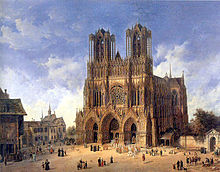
A rebellion of the citizens, which was directed against the collection of the salt tax , was in 1461 by Louis XI. dejected. In the Huguenot Wars , the city was on the side of the Catholic League from 1585, but submitted to King Henry IV in 1590. The prosperity of the city, which was based primarily on the wool industry, became apparent. a. under construction of a representative city palace in the period of absolutism.
As a result of the French Revolution which was province of Champagne dissolved and Reims new department assigned Marne. The coronation of Napoleon , unlike that of the French kings, did not take place in Reims, but in Paris. In early 1814 the Reims area was fiercely contested before Napoleon abdicated. The medieval defensive wall was torn down in the middle of the 19th century. Gradually industrialization began, and in 1854 the railroad reached Reims. In 1870/71 the Prussians made Reims the seat of a governor-general, with the city suffering from high contributions .
From August 22 to 29, 1909, Reims was the scene of the first international flight week , during which Louis Blériot , Hubert Latham and Henri Farman set several records.
World Wars and Reconstruction
During the First World War , the city, which had around 120,000 inhabitants in 1914 and was almost immediately behind the front line, was devastated by around 60% mainly by German, but also French artillery shells and air raids. Most of the civilian population was evacuated in March 1918. On January 17, 1919, the Comtesse de Mun launched the “ Back to Reims ” ( Retour à Reims ) campaign , which allowed those in need to get free mattresses, furniture and linen. Wealthy people could rent furniture for three months. The “Back to Reims” campaign also ran four public canteens. In July 1919 Reims was declared a "city of martyrs " ( ville martyre ) on the occasion of a visit by French President Raymond Poincaré . Only 25,000 inhabitants had been able to re-establish themselves in the ruined city.
As early as 1915, the city councils of Reims were thinking about the reconstruction. In April 1920, the newly elected government under Mayor Charles Roche passed an ambitious plan by US Army major Georges B. Ford for reconstruction. The reconstruction (la reconstruction) of the inner city took place in the 1920s in the style of Art Deco . The reconstruction of Reims turned the city into a single construction site for years, first with the construction of public buildings and trading houses and with the repair of houses that could still be "saved". This was followed by the complete rebuilding of entire streets. The reconstruction of the residential buildings was essentially completed around 1930, that of the cathedral not until 1938, that of the Saint-Remi basilica in 1958 and that of the bell tower of the Church of St. James in 1994. On May 7, 1945, Colonel-General Alfred Jodl signed in Reims, at the then headquarters of General Dwight D. Eisenhower , Commander-in-Chief of the SHAEF , the unconditional surrender of the German Wehrmacht . The reconciliation meeting between President Charles de Gaulle and Konrad Adenauer also took place in Reims in 1962 .
The tomb of Edouard Marius Ivaldi nearby is the only surviving individual war grave.
politics
mayor
The incumbent for 2014–2020 is Arnaud Robinet (Les Républicains).
Twin cities
|
|
coat of arms
Blazon : "In silver with with gold lilies added besätem shield main two green, crossed at both ends and a ring as defined laurel branches ."
(French: "D'argent aux deux rinceaux de laurier de sinople passés en double sautoir, au chef d'azur semé de fleurs de lys d'or." )
Culture and sights
The most important squares in Reims are the Place Royale ("Royal Square") with a statue of Louis XV. , and the Place du Parvis ("church square") with a statue of Joan of Arc . The main main street, Rue de Vesle , crosses the city from southwest to northeast, crossing Place Royale . The oldest monument in the city is the Marstor ( la Porte de Mars ), a 33 meter long and 13 meter high triumphal arch ( arc de triomphe ) with three arches.
See also: List of Monuments historiques in Reims
Churches
Notre-Dame de Reims cathedral
The Notre-Dame de Reims cathedral is considered one of the most architecturally significant Gothic churches in France. The French kings were crowned here from the twelfth to the 19th century . Since 1991, it is one next to the Palais du Tau and the Saint-Remi to UNESCO - World Heritage Site .
The Saint-Remi basilica
The Saint-Remi basilica , which is almost the size of the cathedral, used to belong to an important abbey . Important building epochs of the basilica were the eleventh ( crypt ), twelfth ( choir ), thirteenth ( apse ) and 15th century (south transept ). The basilica was sacked during the French Revolution . However, colored windows from the twelfth century are still preserved.
The churches of Saint-Jacques, Saint-Maurice, Saint-André and Saint-Thomas are less interesting architecturally and historically. Only a few ruins remain of the Saint-Nicaise church .
Palaces, theaters and libraries
The Palace of Tau ( Palais du Tau )
The Archbishop's Palace was built between 1498 and 1509. It hosted the French kings at their coronation celebrations. The mighty fireplace in the main salon ( Salle du Tau ) from the 15th century is particularly impressive . The chapel and main salon are adorned with 17th century tapestries . The name of the palace is borrowed from the similarity of the palace's floor plan to the Greek letter tau .
Cours Langlet
The facades along the splendid boulevard leading to the cathedral are a résumé of the architectural options for the reconstruction of the city that was destroyed in the First World War.
Grand Théâtre
An Art Deco building of national importance, the theater opened in 1931. The fountain bowls and a bas-relief, wrought-iron banisters with golden masks and a mighty breastplate chandelier under the dome are striking.
Bibliothèque Andrew Carnegie
The Carnegie Library opened in 1928 and named after the American billionaire and philanthropist Andrew Carnegie , a financier of the reconstruction of the city after the First World War. Looking like a small Greek temple from the outside, the vestibule presents itself as a refined Art Deco jewel. “Particularly noteworthy are the semi-cylindrical shape, which is unusual for France, and the wonderful mosaics and glass basins in the entrance area. Around 400,000 documents are stored here. "
Other sights
Founded in 1794 during the Revolution , the Museum of Fine Arts ( Musée des beaux-arts de Reims ), which has been in the old Abbey of Saint-Denis since 1908, houses an interesting collection of mainly Flemish, Dutch and French paintings. In addition, the remains of the Roman amphitheater have been preserved. To defend the urban area, the Fort de la Pompelle was built around 1880 on the area of the municipality of Puisieulx , southeast of Reims.
The Museum of the Handover Declaration ( Musée de la Reddition ) shows, among other things, the room with General Eisenhower's general staff cards , in which Colonel General Jodl , on behalf of Karl Dönitz , signed the declaration of surrender of the German Wehrmacht on May 7, 1945 .
In the north of Reims is the Notre-Dame de la Paix chapel by the Japanese-French artist Tsuguharu-Leonard Foujita (consecrated 1966). The chapel's windows were made by the glass builder Charles Marq, who also made the Marc Chagall windows in Notre-Dame Cathedral . In the chapel the life of Jesus is depicted in frescoes. Foujita's style is explicitly based on Leonardo da Vinci , from which he also chose his second - Christian - first name. In doing so, he builds a thematic bridge to modernity by referring to the atomic bombs being dropped on Hiroshima and Nagasaki in the macabre dances . Foujita is buried in the chapel.
Festivals
The Clin d'oeil , the largest sign-language cultural festival in Europe, has been held in Reims every two years since 2003 .
Economy and Infrastructure
traffic
Reims was already at the intersection of several important roads in Roman times. The central train station on the north-western edge of the city center, which has been in operation since 1854, is where the regional railway lines, operated by one of the TER subsidiaries of the SNCF, essentially meet . Most of the long-distance traffic stops at the newly created Champagne-Ardenne TGV station 4½ km south of the city center in the neighboring municipality of Bezannes . Shuttle trains run regularly between the two stations. The Autoroute de l'Est originally ran through the middle of the city, less than a kilometer from the cathedral, along the Canal de l'Aisne à la Marne, which has existed since 1866 . A large-scale bypass from Reims has been in operation since 2010, and the original A4 on this section was renamed the A344. In April 2011 the Reims tram went into operation; the eleven-kilometer route network is served by two lines. There are also buses.
science and technology
Reims is the seat of a university. The " University of Reims and the Champagne-Ardenne region " (French. Université de Reims Champagne-Ardenne, abbreviated URCA ) was created in 1971 from several higher education institutions founded in the 1960s. It stands in the tradition of a 1548 on the proposal of the Cardinal of Lorraine by Pope Paul III. Cathedral school raised to university , but which was dissolved again in 1793. The natural science Faculté des Sciences is located in the southeast of the city, the humanities Faculté des Lettres in the southwest. The university also has branches in Troyes , Charleville-Mézières and Châlons-en-Champagne . There is also a campus of the renowned Sciences Po Paris in the former Jesuit monastery in Reims .
The University Hospitals (Centers Hospitaliers Universitaires de Reims), the largest employer in the city, are partly concentrated in a large area in the south and partly spread over the whole city.
Reims is the seat of the aircraft manufacturer Reims Aviation .
champagne
Along with Épernay, Reims is the most important center of champagne production . Some of the champagne is stored in cellars and tunnels that were dug into the limestone rocks as early as the Roman times .
Champagne parent company
G. H. Mumm (1896–1898)
military
The large airfield in the northern neighboring municipality of Bétheny was the Air Force Base Base aérienne 112 Reims-Champagne until 2011 and was the third largest employer in the area after the university clinic and municipal facilities. According to the strategically important location, there are several other (former) barracks, including the Caserne Jeanne-d'Arc and the Caserne Colbert .
Sports
One of the oldest sports clubs in the city is Régates rémoises, a rowing club founded in 1854 and still active and successful today . In Reims, the football club's Stade de Reims home, in particular in the two decades following the Second World War, the professional sport of football in France dominated (six league titles and two cup wins in men to a decade later, five national championships for women). Today (2018/19 season) Stade plays in Ligue 1 ; He plays his home games at the Stade Auguste-Delaune , the new building of which was completed in 2008.
Reims has been known since 1926 for the Circuit de Reims-Gueux motorsport race track, seven kilometers to the west , on which Formula 1 races were also held. The route was closed in 1972. Remnants of the track system are still preserved today.
The first official three-cushion world championship also took place in Reims in 1928 . In addition, the city with its Stade Vélodrome was a Mecca for French track cycling, especially in the 1950s . In 2010 Reims was the 11th stage of the Tour de France since 1936 .
A marathon has been held in Reims in October since 1984, which is now part of the Reims à toutes jambes running event, along with a half marathon and a 10 km run .
Personalities
sons and daughters of the town
- Jeanne Added (* 1980), singer-songwriter and jazz musician
- Albert Batteux (1919–2003), soccer coach and soccer player
- Jean Baudrillard (1929–2007), philosopher and sociologist
- Bruno Bonhuil (1960–2005), motorcycle racer
- Jean-François Boulart (1776–1842), general of the artillery
- Ludovic Butelle (born 1983), football player
- George Casalis (1917–1987), Protestant Reformed pastor, resistance fighter, liberation theologian and university professor.
- Pierre Cauchon (around 1370 - 1442), Bishop of Beauvais and royal adviser
- Léon Chavalliaud (1858–1919), sculptor
- Barbe-Nicole Clicquot-Ponsardin (1777–1866), champagne industrialist
- Jean-Baptiste Colbert (1619–1683), statesman and founder of mercantilism
- Baude Cordier (before 1364 - before 1400), composer and harp player of the early Renaissance
- Maurice Couve de Murville (1907-1999), conservative politician
- Laurent Cuniot (* 1957), composer, conductor and music teacher
- Henri Dallier (1849–1934), composer and organist
- Antoine Dorfeuille (1754–1795), actor, publicist and revolutionary
- Jean-Baptiste Drouet d'Erlon (1765–1844), revolutionary general
- Philippe Entremont (* 1934), pianist and conductor
- Didier Eribon (* 1953), philosopher and author
- Maurice Falvy (1888-1970), General
- Pauline Ferrand-Prévot (* 1992), cyclist
- Marion Fiack (* 1992), pole vaulter
- Bernard Fresson (1931–2002), film actor
- Marie Gayot (* 1989), track and field athlete
- Pierre Geoffroy (1939–1994), journalist, football coach and official
- Daniel Goeudevert (* 1942), manager and business consultant
- Élodie Gossuin (* 1980), model
- Philippe Haezebrouck (* 1954), racing car driver
- Henri Heintz (* 1946), racing cyclist
- Joseph-Jean Heintz (1886–1958), Roman Catholic bishop
- Philippe Henriot (1889–1944), politician in the Pétain government
- Gunthar von Hildesheim († 835), bishop of the Hildesheim diocese
- Johann-Joseph Krug (1800–1866), German entrepreneur, founder of the Krug champagne house
- Jean Baptiste de La Salle (1651–1719), priest, educator and founder of an order
- Simon Nicolas Henri Linguet (1736–1794), writer
- René Masclaux (* 1945), football player
- Armand Marcelle (1905–1974), rower
- Édouard Marcelle (1909-2001), rower
- Henri Marteau (1874–1934), German-French violinist and composer
- Olivier Métra (1830–1889), composer and conductor
- Edmond Missa (1861-1910), composer
- Marcel Moreau (born 1936), football player
- Jean-David Morvan (* 1969), comic artist
- Alexandre Noll (1890–1970), wood sculptor and furniture designer
- Nelson Panciatici (* 1988), racing driver
- Robert Pires (* 1973), football player
- Louis-Marie Rocourt (1743–1824), last abbot of Clairvaux
- Léon Rothier (1874–1951), singer (bass)
- Catherine Vautrin (* 1960), politician
- Jakob von Vitry (1160 / 70–1240), cardinal
- Woodkid (Yoann Lemoine) (* 1983), musician and director
Lived and died in Reims
- Abel of Reims , († 764), Archbishop of Reims
- Robert Briçonnet († 1497), Archbishop of Reims
- Brun (925–965), Archbishop of Cologne and brother of Otto I.
- Flodoard von Reims (894–966), West Franconian chronicler
- Tsuguharu-Léonard Foujita (1886–1968), Japanese-French painter and graphic artist; buried in the Foujita Chapel designed by him in Reims
- Henri Germain (1906–1990), football official
- Florenz-Ludwig Heidsieck (1749–1828), Franco-German entrepreneur, founder of the Champagne House
- Robert Jonquet (1925–2008), national soccer player
- Karlmann I (751–771), brother of Charlemagne, King of the Franks
- Johann-Joseph Krug (1800–1866), Franco-German entrepreneur and founder of the Krug champagne house
- Benoît-Marie Langénieux (1824–1905), Archbishop of Reims
- Hugo Libergier (1229–1263), master builder of French high Gothic
- Alfred Lichtenstein (1889–1914), German lawyer and expressionist writer
- Liutwin († 717), founder of the monastery in Mettlach and bishop in Trier, Laon and Reims
- Louis-Henri-Joseph Luçon (1842–1930), Archbishop of Reims
- Ludwig IV (920 / 21–954), king of western France
- Guillaume de Machaut (1300 / 05–1377), composer and poet
- Herbert MacKay-Fraser (1927–1957), American racing driver
- Jean-Marie Maury (1907–1994), Archbishop of Reims
- Luigi Musso (1924–1958), Italian Formula 1 and sports car racing driver
- Philip VI (1293–1350), King of France
- Remigius of Reims (≈436–533), Gallo-Franconian bishop, baptized the Merovingian king Clovis I.
- Turpin of Reims (before 751–794), first archbishop in Reims
- Eduard Werle (1801–1884), Mayor of Reims and deputy in the French parliament
literature
- Monika Bugs, Patrick Demouy, Wolfgang Kraus: Message from the stones. Medieval stone tablets and contemporary frottages in dialogue. = Message des pierres. Dalles médiévales et Frottages contemporains en dialogue . Legat Verlag, Tübingen 2007, ISBN 978-3-932942-26-6 .
- Patrick Demouy: Reims - The Cathedral . Schnell + Steiner u. a., Regensburg u. a. 2001, ISBN 3-7954-1388-5 .
- Olivier Rigaud: Reims au temps de l'Art déco . Éditions du Huitième Jour, Paris 2006, ISBN 2-914119-60-7 .
- Olivier Rigaud: Reims à l'époque de l'Art Déco. Une ville reconstruite après la première guerre mondiale (= Collection Patrimoine Ressources ). SCÉRÉN-CRDP Champagne-Ardenne, Reims 2006, ISBN 2-86633-421-3 (with CD-ROM).
Web links
- City of Reims website (multilingual)
- Photos of the Cathedral and Basilica of St. Remi
- Reims. First World War and Reconstruction (richly illustrated, French)
- www.monika-bugs.de - “Hommage à saint Remi” project. Frottages based on the medieval stone tablets of Saint-Nicaise, kept in the Saint-Remi basilica. (German and French)
- Chapelle Foujita on ville-reims.fr (French)
- Le musée de la Reddition on ville-reims.fr Museum of the Declaration of Delivery (French)
Individual evidence
- ↑ a b Reims Tourist Guide 2015.
- ↑ Calendar sheet August 22 in: Nordbayerischer Kurier from August 22, 2019, p. 2.
- ↑ On their retreat to the Marne, the French artillery shelled the city occupied by the German troops (Reichsarchiv Das Marne Drama, part 2 )
- ^ The Reims bus network
- ^ Center Hospitalier Universitaire de Reims (in French)
← Previous location: Hermonville 16.3 km | Reims | Next town: Trépail 28.1 km →
![]() Canterbury |
Dover |
Calais |
Wissant |
Guînes |
Licques |
Wisques |
Thérouanne |
Auchy-au-Bois |
Bruay-la-Buissière |
Arras |
Bapaume |
Peronne |
Doingt |
Seraucourt-le-Grand |
Tergnier |
Laon |
Bouconville-Vauclair |
Corbeny |
Hermonville |
Reims |
Trépail |
Châlons-en-Champagne |
Cool |
Brienne-le-Château |
Bar-sur-Aube |
Châteauvillain |
Blessonville |
Langres |
Humes-Jorquenay |
Coublanc |
Grenant |
Dampierre-sur-Salon |
Savoyeux |
Seveux |
Gy |
Cussey-sur-l'Ognon |
Besançon |
Étalans |
Chasnans |
Nods |
Ouhans |
Pontarlier |
Yverdon-les-Bains |
Orbe |
Lausanne |
Cully |
Vevey |
Montreux |
Villeneuve |
Aigle |
Saint-Maurice |
Martigny |
Orsières |
Bourg-Saint-Pierre |
Great St. Bernhard |
Saint-Rhémy-en-Bosses |
Saint-Oyen |
Étroubles |
Gignod |
Aosta |
Saint-Christophe |
Quart |
Nut |
Verrayes |
Chambave |
Saint-Denis |
Châtillon |
Saint-Vincent |
Montjovet |
Issogne |
Verrès |
Arnad |
Hône |
Bard |
Donnas |
Pont-Saint-Martin |
Carema |
Settimo Vittone |
Borgofranco d'Ivrea |
Montalto Dora |
Ivrea |
Cascinette d'Ivrea |
Burolo |
Bollengo |
Palazzo Canavese |
Piverone |
Azeglio |
Viverone |
Roppolo |
Cavaglià |
Santhià |
San Germano Vercellese |
Olcenengo |
Salasco |
Sali Vercellese |
Vercelli |
Palestro |
Robbio |
Nicorvo |
Castelnovetto |
Albonese |
Mortara |
Cergnago |
Tromello |
Garlasco |
Gropello Cairoli |
Villanova d'Ardenghi |
Zerbolò |
Carbonara al Ticino |
Pavia |
Valle Salimbene |
Linarolo |
Belgioioso |
Torre de 'Negri |
Costa de 'Nobili |
Santa Cristina e Bissone |
Miradolo Terme |
Chignolo Po |
San Colombano al Lambro |
Orio Litta |
Senna Lodigiana |
Calendasco |
Rottofreno |
Piacenza |
Podenzano |
San Giorgio Piacentino |
Pontenure |
Carpaneto Piacentino |
Cadeo |
Fiorenzuola d'Arda |
Chiaravalle della Colomba |
Alseno |
Busseto |
Fidenza |
Costamezzana |
Noceto |
Medesano |
Fornovo di Taro |
Terenzo |
Berceto |
Pontremoli |
Filattiera |
Villafranca in Lunigiana |
Bagnone |
Licciana Nardi |
Aulla |
Santo Stefano di Magra |
Sarzana |
Castelnuovo Magra |
Ortonovo |
Luni |
Fosdinovo |
Carrara |
Massa |
Montignoso |
Seravezza |
Pietrasanta |
Camaiore |
Lucca |
Capannori |
Porcari |
Montecarlo |
Altopascio |
Castelfranco di Sotto |
Santa Croce sull'Arno |
Ponte a Cappiano |
Fucecchio |
San Miniato |
Castelfiorentino |
Coiano |
Montaione |
Gambassi Terme |
San Gimignano |
Colle di Val d'Elsa |
Badia a Isola |
Monteriggioni |
Siena |
Monteroni d'Arbia |
Ponte d'Arbia |
Buonconvento |
Montalcino |
Torrenieri |
San Quirico d'Orcia |
Bagno Vignoni |
Castiglione d'Orcia |
Radicofani |
San Casciano dei Bagni |
Abbadia San Salvatore |
Piancastagnaio |
Ponte a Rigo |
Proceno |
Acquapendente |
Grotte di Castro |
San Lorenzo Nuovo |
Bolsena |
Montefiascone |
Viterbo |
Ronciglione |
Vetralla |
Capranica |
Sutri |
Monterosi |
Nepi |
Mazzano Romano |
Campagnano di Roma |
Formello |
La Storta |
Rome
Canterbury |
Dover |
Calais |
Wissant |
Guînes |
Licques |
Wisques |
Thérouanne |
Auchy-au-Bois |
Bruay-la-Buissière |
Arras |
Bapaume |
Peronne |
Doingt |
Seraucourt-le-Grand |
Tergnier |
Laon |
Bouconville-Vauclair |
Corbeny |
Hermonville |
Reims |
Trépail |
Châlons-en-Champagne |
Cool |
Brienne-le-Château |
Bar-sur-Aube |
Châteauvillain |
Blessonville |
Langres |
Humes-Jorquenay |
Coublanc |
Grenant |
Dampierre-sur-Salon |
Savoyeux |
Seveux |
Gy |
Cussey-sur-l'Ognon |
Besançon |
Étalans |
Chasnans |
Nods |
Ouhans |
Pontarlier |
Yverdon-les-Bains |
Orbe |
Lausanne |
Cully |
Vevey |
Montreux |
Villeneuve |
Aigle |
Saint-Maurice |
Martigny |
Orsières |
Bourg-Saint-Pierre |
Great St. Bernhard |
Saint-Rhémy-en-Bosses |
Saint-Oyen |
Étroubles |
Gignod |
Aosta |
Saint-Christophe |
Quart |
Nut |
Verrayes |
Chambave |
Saint-Denis |
Châtillon |
Saint-Vincent |
Montjovet |
Issogne |
Verrès |
Arnad |
Hône |
Bard |
Donnas |
Pont-Saint-Martin |
Carema |
Settimo Vittone |
Borgofranco d'Ivrea |
Montalto Dora |
Ivrea |
Cascinette d'Ivrea |
Burolo |
Bollengo |
Palazzo Canavese |
Piverone |
Azeglio |
Viverone |
Roppolo |
Cavaglià |
Santhià |
San Germano Vercellese |
Olcenengo |
Salasco |
Sali Vercellese |
Vercelli |
Palestro |
Robbio |
Nicorvo |
Castelnovetto |
Albonese |
Mortara |
Cergnago |
Tromello |
Garlasco |
Gropello Cairoli |
Villanova d'Ardenghi |
Zerbolò |
Carbonara al Ticino |
Pavia |
Valle Salimbene |
Linarolo |
Belgioioso |
Torre de 'Negri |
Costa de 'Nobili |
Santa Cristina e Bissone |
Miradolo Terme |
Chignolo Po |
San Colombano al Lambro |
Orio Litta |
Senna Lodigiana |
Calendasco |
Rottofreno |
Piacenza |
Podenzano |
San Giorgio Piacentino |
Pontenure |
Carpaneto Piacentino |
Cadeo |
Fiorenzuola d'Arda |
Chiaravalle della Colomba |
Alseno |
Busseto |
Fidenza |
Costamezzana |
Noceto |
Medesano |
Fornovo di Taro |
Terenzo |
Berceto |
Pontremoli |
Filattiera |
Villafranca in Lunigiana |
Bagnone |
Licciana Nardi |
Aulla |
Santo Stefano di Magra |
Sarzana |
Castelnuovo Magra |
Ortonovo |
Luni |
Fosdinovo |
Carrara |
Massa |
Montignoso |
Seravezza |
Pietrasanta |
Camaiore |
Lucca |
Capannori |
Porcari |
Montecarlo |
Altopascio |
Castelfranco di Sotto |
Santa Croce sull'Arno |
Ponte a Cappiano |
Fucecchio |
San Miniato |
Castelfiorentino |
Coiano |
Montaione |
Gambassi Terme |
San Gimignano |
Colle di Val d'Elsa |
Badia a Isola |
Monteriggioni |
Siena |
Monteroni d'Arbia |
Ponte d'Arbia |
Buonconvento |
Montalcino |
Torrenieri |
San Quirico d'Orcia |
Bagno Vignoni |
Castiglione d'Orcia |
Radicofani |
San Casciano dei Bagni |
Abbadia San Salvatore |
Piancastagnaio |
Ponte a Rigo |
Proceno |
Acquapendente |
Grotte di Castro |
San Lorenzo Nuovo |
Bolsena |
Montefiascone |
Viterbo |
Ronciglione |
Vetralla |
Capranica |
Sutri |
Monterosi |
Nepi |
Mazzano Romano |
Campagnano di Roma |
Formello |
La Storta |
Rome![]()
![]()
![]()





